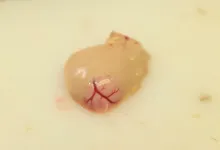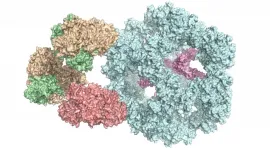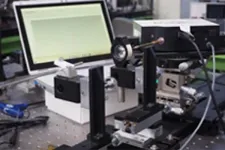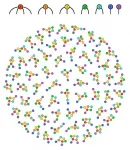(Press-News.org) The recent review, published in Environment International and led by the University of Tartu, summarises the effect of aquatic pollution on cancer prevalence in wild animals with the help of more than 300 reviewed studies. Authors shed light on understudied yet important fields in cancer research in wild animals - summarising the key effects and pointing to future research avenues to crack the puzzle of why cancer develops in polluted environments.
„What was immediately evident was the bias towards fish in current research into aquatic wildlife cancer. However, given this bias it is especially interesting that 10% of the aquatic animals diagnosed with cancer, have had this cancer associated with pollution; a figure we expect to be a lot higher in reality," says Ciara Baines, lead author of the review.
The new article combines the information available within the scientific literature on cancer occurrences in aquatic and semi-aquatic species. The authors suggest physiological mechanisms that link pollution and cancer, including main metabolic detoxification pathways, oxidative damage effects, infections, and changes to the microbiome. In addition, it is determined: which types of aquatic animals are more vulnerable to pollution-induced cancer, which types of pollution are mainly associated with cancer in aquatic ecosystems, and which types of cancer pollution causes.
All aquatic ecosystems are vulnerable to pollution
Toxic substances such as persistent organic pollutants, pesticides, and heavy metals, but also pharmaceuticals and microplastics, have been shown to negatively affect the health and survival of aquatic organisms. One of the pollution-induced pathologies that should be at the centre of attention in ecological and evolutionary research is cancer, as anthropogenic contamination has resulted in a rapid increase of oncogenic substances in natural habitats.
Pollutants can suppress the host immune system and thus increase the susceptibility of organisms to cancer-causing pathogens and/or the long-term accumulation of pollutants and tissue damage in organs. This in turn, can initiate oncogenic processes. Based on the current review, cancer has been linked to pollution in around 30 aquatic species.
Skin cancer is a frequent outcome of living in contaminated waters in several fish species. Accordingly, next to skin cancer, cancers of the liver, that assist in processing contaminants, have been described in many fish species. Interestingly, malignant tumours in lipid-rich brain tissues, which could be a promising future study direction, are often under-described
and under-studied throughout the literature. Pointing to the gaps in research was one of the aims of a review.
Tuul Sepp, PI of the research group of cancer evolution in University of Tartu, highlights two sides of the coin in wildlife cancer studies: „On the one hand, if our activities are causing cancer in aquatic animals, it is our responsibility to know about it, to try to make it better. On the other hand, wild animals in polluted environments act as sentinels for the environmental quality for humans."
A better understanding of tumour development processes and linkage to the contamination of the environment with oncogenic chemicals has an important role in preventing the negative effects of contamination on wild populations as well as humans.
The authors highlight the need for future research to target understanding how exposure to a chronic low-to-medium oncogenic pollutant level, combined with other ecological factors affects the health of aquatic animals. In addition, understanding the combined effects of environmental parameters and pollution cocktails on cancer prevalence is an area that needs urgent research.
INFORMATION:
Sophia Antipolis, 10 February 2021: A nationwide US study has found increasing death rates from heart disease in women under 65. The research is published in European Heart Journal - Quality of Care and Clinical Outcomes, a journal of the European Society of Cardiology (ESC).1 The study found that while death rates from cancer declined every year between 1999 and 2018, after an initial drop, heart disease death rates have been rising since 2010.
"Young women in the US are becoming less healthy, which is now reversing prior improvements in heart disease deaths," said senior author Dr. Erin Michos of Johns Hopkins University School of Medicine, Baltimore, US. "With ...
Satellite images reveal that the timing of algal blooms in the Red Sea may affect the next haul of sardines and squid by commercial fisheries.
Rising temperatures in the Red Sea have changed the timing of phytoplankton blooms. These microscopic algae form the base of many marine food webs and so are critical to ocean biodiversity and the industries that they support on land, such as fisheries and tourism.
A team led by KAUST climate modeler Ibrahim Hoteit has used satellite images to study the phenology of algal blooms in the northern Red Sea and ...
A new method has enabled the natural structure of particularly large and complex enzymes to be revealed. Scientists at Martin Luther University Halle-Wittenberg (MLU) and TU Berlin have published their findings in the journal Cell Reports. They investigated a multi-enzyme complex that plays an essential role in metabolism and have discovered that it functions differently than previously thought. This will help scientists better understand certain diseases.
Enzymes are a cell's biocatalysts. They accelerate chemical reactions in the body or ensure that these reactions even take place at all. As a result, they play an extremely important role in metabolism. Individual enzymes frequently form a complex with many subunits, as in the case of the ...
In a study conducted at the University of Helsinki, Finland, 136 adults adhered to one of three study diets for 12 weeks. One of them corresponded to the average Finnish diet, containing roughly 70% animal-derived protein of total protein, while most of the plant-based protein originated from cereal products. In the second study diet, half of the protein was derived from plant products and the other half from animal products, while the third one contained 30% animal protein and 70% plant-based protein of total protein.
Sources of animal protein, both red and white meat as well as dairy products, were partially replaced with plant-based proteins by adding a diverse range of legumes, nuts, ...
Your breath holds the key to monitoring fat burning, and now a research group from Tohoku University has created a compact and low-cost device that can measure how our body metabolizes fat.
The device uses an ultraviolet lamp to gauge exhaled acetone gas, which is produced in the blood through the metabolic reaction of fat.
"Precise measurements of acetone gas concentration allows us to determine the body's ability to metabolize fat and develop exercise methods for efficient fat burning," says Professor Yuji Matsuura from Tohoku University's Graduate School of Biomedical ...
Many natural and human-made networks, such as computer, biological or social networks have a connectivity structure that critically shapes their behavior. The academic field of network science is concerned with analyzing such real-world complex networks and understanding how their structure influences their function or behavior. Examples are the vascular network of our bodies, the network of neurons in our brain, or the network of how an epidemic is spreading through a society.
The need for reliable null models
The analysis of such networks often focuses on finding interesting properties and features. For example, does the structure of a particular contact network help diseases spread ...
The research team led by Masakazu Ohara, graduate student of the Department of Computer Science and Engineering at Toyohashi University of Technology (student in the Leading Program doctoral program); Associate Professor Kowa Koida of the Electronics-Inspired Interdisciplinary Research Institute; and Associate Professor Juno Kim of the University of New South Wales (Australia) discovered that when people judge the thickness of an object, objects with glass-like transparent optical properties are perceived to be flatter than they actually are. It was previously known that objects made of metallic or glossy materials are perceived to be thicker than what they are, but now the current research has identified that transparent ...
A description of gravity compatible with the principles of quantum mechanics has long been a widely pursued goal in physics. Existing theories of this 'quantum gravity' often involve mathematical corrections to Heisenberg's Uncertainty Principle (HUP), which quantifies the inherent limits in the accuracy of any quantum measurement. These corrections arise when gravitational interactions are considered, leading to a 'Generalized Uncertainty Principle' (GUP). Two specific GUP models are often used: the first modifies the HUP with a linear correction, while the second introduces a quadratic one. Through new research published in EPJ C, Serena Giardino and Vincenzo ...
A unique 'heart-shape', with wisps of gas filaments showing an intricate honeycomb-like arrangement, has been discovered at the centre of the iconic supernova remnant, the Crab Nebula. Astronomers have mapped the void in unprecedented detail, creating a realistic three-dimensional reconstruction. The new work is published in Monthly Notices of the Royal Astronomical Society.
The Crab, formally known as Messier 1, exploded as a dramatic supernova in 1054 CE, and was observed over the subsequent months and years by ancient astronomers across the ...
Dimerization (Note: combination of two identical or different molecules) of the human neuropeptides oxytocin and vasopressin can produce new types of bioactive molecules. In a recent study, an international research team led by MedUni Vienna and the University of Vienna demonstrated that dimerized and therefore significantly larger versions of oxytocin and vasopressin are still able to activate their receptors. Such new constructs provide several opportunities to optimize the efficacy of these neuropeptides for therapeutic application. The researchers were inspired for this approach from naturally occurring dimers. The results have been published in the journal "Chemical Science".
Oxytocin/vasopressin receptors are typical examples of so-called G protein-coupled receptors - the most ...




